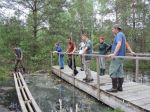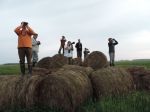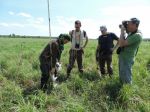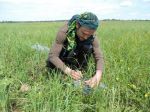Visit from Estonia
30 wrzesień 2014
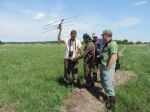 From 20th to 23rd May we have hosted researchers from Estonian University of Life Sciences in PTOP's field station in Kalitnik. The aim of the visit was to exchange experiences relating to the scientific part of the great snipe conservation project. At its beginning – in late fall 2012 – we have visited the University's site in Tartu, where experts investigating this species for 20 years shared with us valuable information on performing habitat and telemetric studies. This time, we had the chance to present our results and show great snipes' sanctuaries in the Podlasie region, an in the Upper Narew River Valley in particular.
From 20th to 23rd May we have hosted researchers from Estonian University of Life Sciences in PTOP's field station in Kalitnik. The aim of the visit was to exchange experiences relating to the scientific part of the great snipe conservation project. At its beginning – in late fall 2012 – we have visited the University's site in Tartu, where experts investigating this species for 20 years shared with us valuable information on performing habitat and telemetric studies. This time, we had the chance to present our results and show great snipes' sanctuaries in the Podlasie region, an in the Upper Narew River Valley in particular.
On the first day, we have visited selected most interesting sites in the Gródek-Michałów Depression, among others the Gorbacz nature reserve and a lekking site located in meadows managed by PTOP, whereas near the field station in Kalitnik we observed predators – a lesser spotted eagle, an European honey buzzard, and a Montagu's harrier. A great ornithological attraction for our guests was a hoopoe, extremely rare in Estonia. In the evening, we have acquainted ourselves with preliminary results on migration pathways of the Estonian population. Andres Kuresoo desribed a visit to Ethiopia, where a part of the migrating birds take rest, and Michał Korniluk presented results of telemetric and habitat studies which we have collected last year.
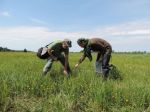 We have spent the next day by the Narew River, where, divided in two groups, equipped with VHF antennas, we have been tracking great snipes. From sites, where startling of foraging birds was observed, soil samples for entomological studies were collected, and parameters characterizing microhabitats – such as soil humidity and cohesiveness – were measured. We have also taken notes on vegetation structure and the behavior of startled individuals.
We have spent the next day by the Narew River, where, divided in two groups, equipped with VHF antennas, we have been tracking great snipes. From sites, where startling of foraging birds was observed, soil samples for entomological studies were collected, and parameters characterizing microhabitats – such as soil humidity and cohesiveness – were measured. We have also taken notes on vegetation structure and the behavior of startled individuals.
In the evening, we have visited the lekking site in order to capture birds and fit them with further transmitters. Unfortunately, he site was not active that evening, and therefore we have not managed to capture any great snipes. We have, on the other hand, received several helpful suggestions concerning methods of successful captures.
On the third day, the Estonian delegation visited Siemianówka and Białowieża Primeval Forest, and – upon their return – joined us in the Upper Narew River Valley. There, we have visited, among others, one of the historical great snipe lekking sites, and a site discovered this year for the first time, where by counting calling birds and using flashlights we have established the number of lekking individuals. On Friday morning, we bade farewell to our guests, who continued to the Biebrza River Valley, where they had the chance to observe aquatic warblers and white-winged terns.



